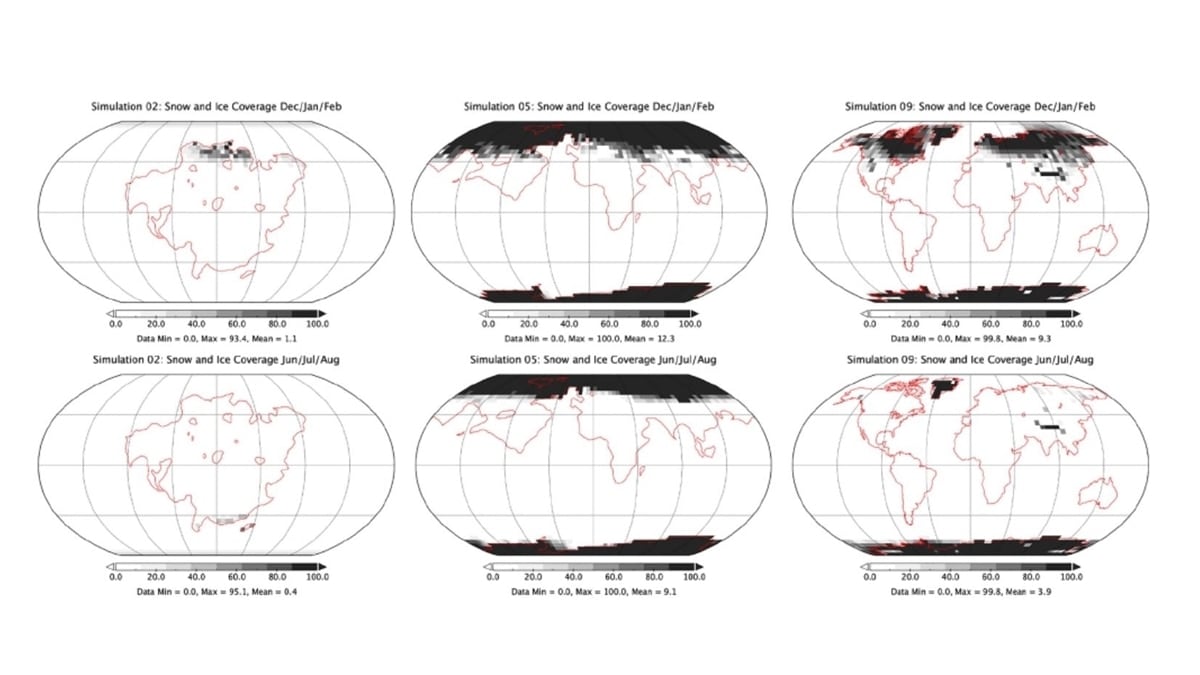By HT TECH
Updated on 03 Sep 2021,

NASA shows that Earth is set for a massive change as all continents will merge into a single or at most 2 continents above the Equator in the future and it maps climate change too.
(Geochemistry, Geophysics and Geosystems)
Researchers at NASA have been looking into the evolution of plate tectonics on Earth, its slower rotation rate, and the Sun’s increased brightness to predict planet's terrestrial future as well as chart climate change.
Earth’s evolution over millions of years has been driven by shifting tectonic plates with the super-continent Pangaea breaking and arranging itself into seven continents and five oceans. And scientists say that these tectonic plates are not done shifting and our planet is still evolving. They have been researching the current structure of the planet to predict how it is going to change over the next 200 to 250 million years.
The research is being led by Michael Way of the NASA Goddard Institute for Space Studies, and the scientists are looking into the evolution of plate tectonics, the Sun’s increased brightness, and slower rotation rate that can change future climate scenarios. And they have found two different scenarios that might occur in the future and the difference in the mean surface temperatures in these two potential cases differ by several degrees Celcius.
“In one case the present-day continents form into a single landmass near the equator, and in the other case Antarctica stays put, but the rest of the present-day continents are mostly pushed well north of the equator,” researchers said in a study published in the “Geochemistry, Geophysics, Geosystems” journal.
Our planet is halfway through current continental formation
Study shows that continents on Earth aggregate into supercontinents and then disperse over a cycle of 400 to 600 million years following something called the supercontinent cycle. "Pangaea formed around 310 million years ago and started breaking up around 180 million years ago. The next supercontinent will most likely form in 200-250 million years, meaning the Earth is currently about halfway through the scattered phase of the current supercontinent cycle," the paper said.
Researchers have also established strong links between large-scale tectonics (the movement of the lithosphere plates) and climate changes and are researching what the Earth’s climate could be like in the distant future when continental movements have changed the planet. According to researchers, there are two plausible formations. One is Aurica, a low latitude supercontinent developing over the next 250 million years, and the second is Amasia, a high latitude northern supercontinent and a smaller Antarctic subcontinent taking shape in about 200 million years. "Amasia is essentially an Arctic supercontinent with an independent and isolated Antarctic continent, meaning both poles are covered by land, and much of that is covered by ice," the paper said.

The future looks something like this, (Geochemistry, Geophysics, Geosystems)
Scientists have designed several models to predict the Earth’s future climate. One set of researchers have explored Earth’s deep-time future climate by looking at the increasing rates of carbon dioxide and solar insolation over time while others are looking into the effects on climate change brought about by changes in topography. They have discovered that while high altitude land on Amasia would lead to the creation of ice sheets, the white supercontinent would reflect back more of the Sun’s heat. And the lack of a northern polar ocean would mean that more ice would be present on land and in lakes through the year near the North Pole like it is in present-day Antarctica. On the other hand, in Aurica, there would be little snow or ice with average temperatures hovering around 20 degrees Celcius
"The geological formations on the ever-changing surface of the Earth have a strong influence on our climate," the researchers said citing how the Himalayas, created by the collision of the India-Eurasia plates, help monsoon climatic conditions.
Studying these climatic changes based on topographic movements also helps astronomers predict a climate model of an Earth-like exoplanet using parameters that are known to sustain habitability and a stable biosphere. "Using the deep-time future Earth as a basis for exoplanetary climate studies allows us to establish sensitivity ranges for the habitability and climate stability of the future Earth and its distant cousins in our galaxy," the paper said.
First Published Date: 03 Sep 2021, 11:37 AM IST
Scientists have designed several models to predict the Earth’s future climate. One set of researchers have explored Earth’s deep-time future climate by looking at the increasing rates of carbon dioxide and solar insolation over time while others are looking into the effects on climate change brought about by changes in topography. They have discovered that while high altitude land on Amasia would lead to the creation of ice sheets, the white supercontinent would reflect back more of the Sun’s heat. And the lack of a northern polar ocean would mean that more ice would be present on land and in lakes through the year near the North Pole like it is in present-day Antarctica. On the other hand, in Aurica, there would be little snow or ice with average temperatures hovering around 20 degrees Celcius
"The geological formations on the ever-changing surface of the Earth have a strong influence on our climate," the researchers said citing how the Himalayas, created by the collision of the India-Eurasia plates, help monsoon climatic conditions.
Studying these climatic changes based on topographic movements also helps astronomers predict a climate model of an Earth-like exoplanet using parameters that are known to sustain habitability and a stable biosphere. "Using the deep-time future Earth as a basis for exoplanetary climate studies allows us to establish sensitivity ranges for the habitability and climate stability of the future Earth and its distant cousins in our galaxy," the paper said.
First Published Date: 03 Sep 2021, 11:37 AM IST
No comments:
Post a Comment